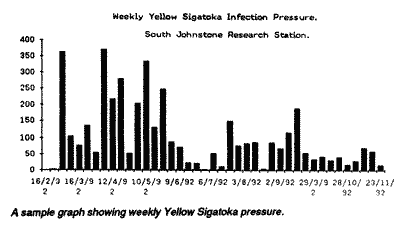
CONTROLLING YELLOW SIGATOKA
SCIENTIFIC NAME: Musa species
FAMILY: Musaceae
Yellow Sigatoka prediction project may mean fewer sprays.
Research being supported by the Queensland banana industry may enable growers to more effectively and cheaply control Yellow Sigatoka.
The research, funded by the Banana Sectional Group Committee (BSGC) and the Horticultural Research and Development Corporation (HRDC), will allow growers to apply Yellow Sigatoka Controls more efficiently by timing their use at the peak danger periods.
Yellow Sigatoka is a problem throughout north Queensland's banana Industry. The disease defoliates trees and can cause mixed ripe problems and yield decline if defoliation is severe.
The present control program is largely preventative, with sprays applied on a regular basis. The research is being carried out by Department of Primary Industries principal plant pathologist Ron Peterson and experimentalists Shane Fitzgerald and Cathy Grice at the South Johnstone Research Station, near Innisfail.
Mr Fitzgerald said the project would develop for the north Queensland industry a system where fungicides were applied only when the likelihood of Yellow Sigatoka infection was high. He said he was currently comparing three different systems of determining when to spray for Yellow Sigatoka based on 'disease pressure'.
"The three methods are the forecasting system, which predicts when infection has occurred based on weather activity, the monitoring system which involves regular checking of leaves to monitor disease development and the scheduled system which is presently used by the industry and required sprays to be applied on a predetermined time schedule," he said.
"The forecasting system utilises weather stations and monitors leaf wetness, temperature and rainfall every five minutes.
"The data is transferred from the weather station to a computer where it is analysed to calculate a cumulative infection pressure (CIP) figure.
"The greater the chance of disease, according to climatic factors, the more points that accumulate.
"When we get to a certain number of points, in this case 250, we spray.
"The monitoring system involves monitoring ten plants within a block both for leaf growth and for symptoms of the infection on the top five leaves.
"The infection on the leaf gets a rating depending on the stage of the disease and the age of the leaf. It is expected that older leaves will be most likely to have the disease, so they score fewer points than you leaves with the disease at the same stage of development.
"When the points for that period reaches a certain threshold we spray.
"The difficulty with this system is that the first stages of Yellow Sigatoka infection are very hard to find and can easily be confused with other diseases.
"However, a significant advantage is that during monitoring you can get an idea of the general health of the block, how the plants are growing and whether there are other pests present."
Mr Fitzgerald said the weather analysis system was "the most promising", and was currently being trialled on-farm. "We seem to get better disease control with the weather system because the timing of the sprays has been better, even though fewer sprays have been applied," he said.
"Hopefully, when the system is finally up and running it will combine elements of both regular monitoring and computer weather analysis."
But, Mr Fitzgerald said, both systems had an inherent weakness.
"With the weather station system, you've observed it to have occurred," he said.
"In this situation, therefore, conventional protective chemicals are going to be of little use.
"The program will not result in savings on sprays in the wet season, when disease pressure is greatest, but it will allow growers to apply systemic fungicides with greater efficiency.

"Prediction systems require sprays with a 'kickback' action, the ability to control the disease after it has entered the plant."
The DPI has established on-line weather stations at South Johnstone, East Palmerston and Mourylian, and there are plans to install a further two at Tully.
Mr Fitzgerald said growers were very interested in the program and had been extremely co-operative.
The DPI is also trialling a number of systemic chemicals for control of Yellow Sigatoka in bananas. Mr Fitzgerald said this was to prevent the Yellow Sigatoka organism developing resistance to the currently-used chemicals.
The trial chemicals are ones in use in banana industries in other countries, or in other crops in Australia.
DATE: January 1994
* * * * * * * * * * * * *
